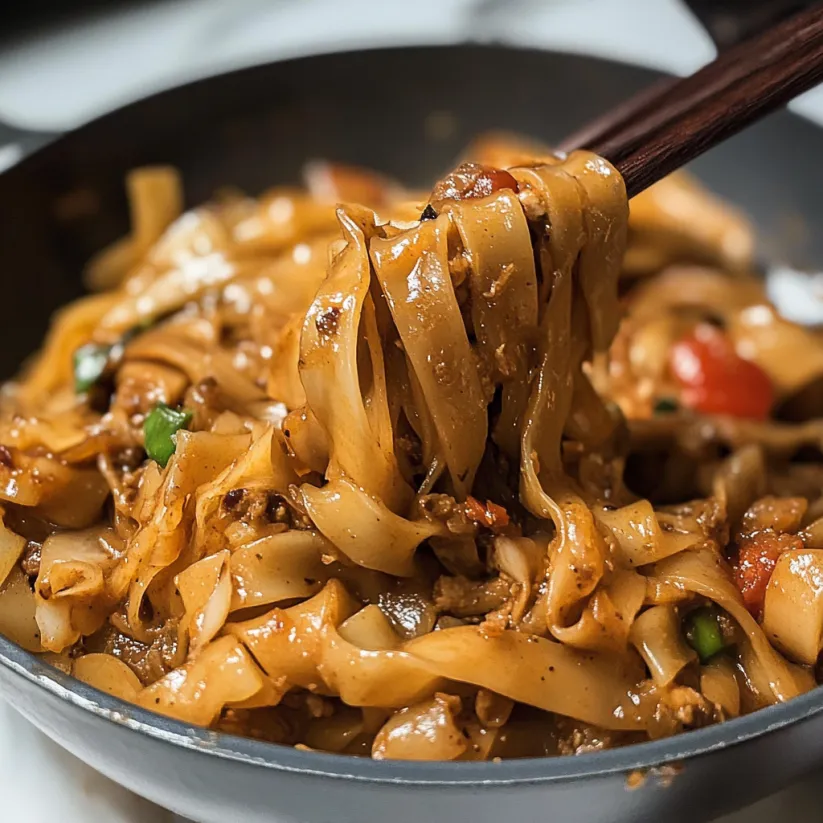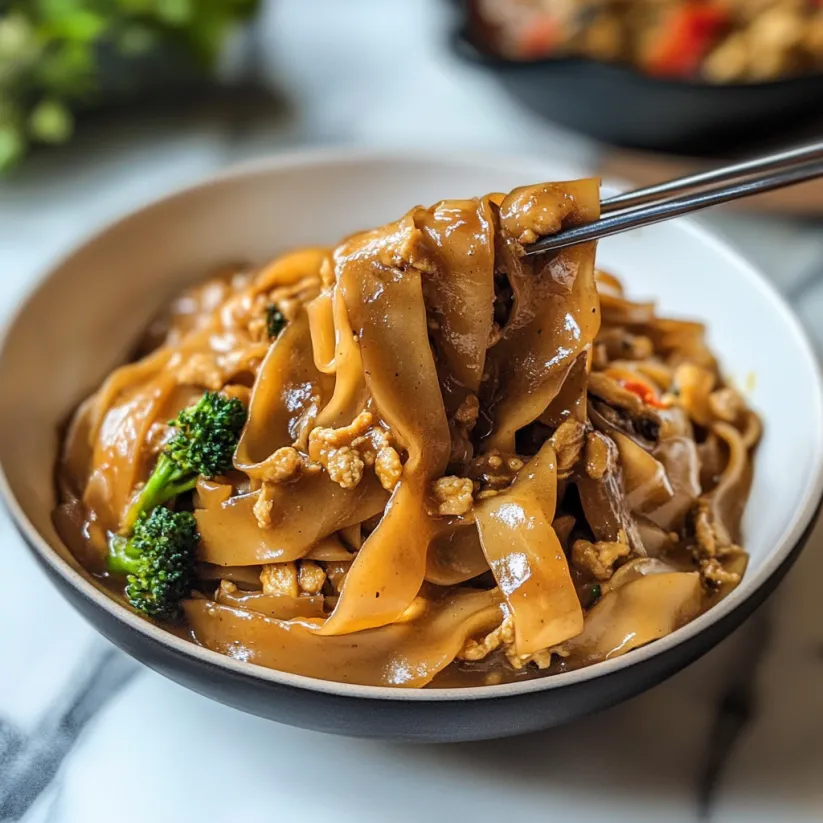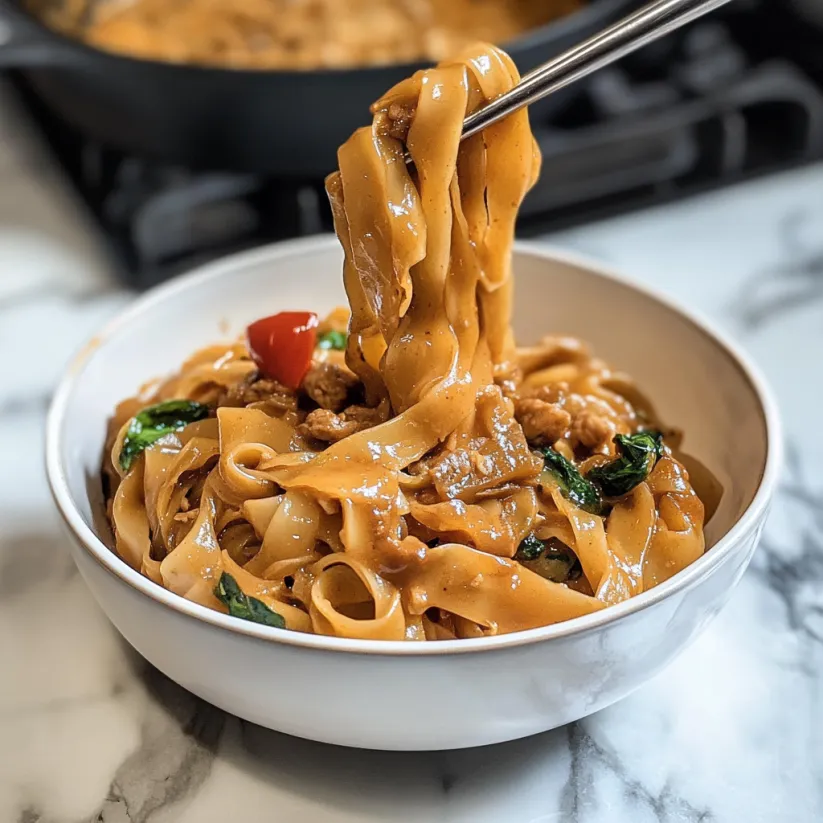 Bookmark
Bookmark
This vibrant vegan drunken noodle recipe brings authentic Thai street food flavors right to your home kitchen in just 20 minutes. The combination of wide rice noodles, fresh vegetables, and aromatic Thai basil creates a restaurant-quality dish that satisfies both spice lovers and plant-based eaters.
I discovered this recipe during a cooking class in Thailand and have been perfecting it for years. My non-vegan friends always request this dish when they visit because the rich umami flavors make them forget it's completely plant-based.
Ingredients
- Fresh wide rice noodles: the star of the dish providing that perfect chewy texture traditional to authentic pad kee mao
- Vegetarian oyster sauce: creates that essential umami depth found in restaurant versions
- Thai basil or holy basil: adds the distinctive aromatic flavor that makes drunken noodles unique
- Thai red chilis: provide that signature heat but you can adjust based on your spice tolerance
- Dark soy sauce: gives the noodles their characteristic rich color and slight sweetness
- Coconut sugar: balances the heat and saltiness with gentle sweetness
Step-by-Step Instructions
- Prepare the noodles:
- Soak rice noodles according to package directions until just tender but still slightly firm. They will finish cooking in the wok so you want them slightly underdone at this stage. Have them ready before starting the stir fry as the cooking process moves quickly.
- Mix the sauce:
- Combine both soy sauces vegetarian oyster sauce coconut sugar water and chili flakes in a small bowl. The dark soy adds color while regular soy provides saltiness. Whisk until sugar completely dissolves to ensure even flavor distribution throughout the dish.
- Stir fry vegetables:
- Heat oil in a wok over medium high heat until shimmering. Add onions green onions bell pepper and cabbage all at once. Keep everything moving constantly for 4 to 5 minutes until vegetables soften but maintain some crispness. The high heat helps develop a slight char that enhances flavor.
- Add aromatics:
- Toss in minced garlic and stir continuously for one minute. This short cooking time releases the garlic flavor without burning it which would create bitterness. The kitchen will fill with an irresistible aroma at this stage.
- Combine everything:
- Add the softened noodles sauce Thai basil and sliced chilis all at once. Use tongs or two spatulas to lift and turn the noodles repeatedly ensuring every strand gets coated in the flavorful sauce. Cook just 1 to 2 minutes until noodles absorb excess liquid and become glossy.
 Bookmark
Bookmark
The vegetarian oyster sauce is my secret ingredient here. I once tried making this with regular soy sauce as a substitute and the depth of flavor was noticeably missing. Since discovering brands like Wa Ja Shan I always keep a bottle in my pantry specifically for this recipe.
Storing Leftovers
These noodles actually develop even more flavor overnight making them ideal for meal prep. Store in an airtight container in the refrigerator for up to 3 days. When reheating add a splash of water and stir fry quickly to prevent the noodles from becoming mushy. The noodles tend to absorb sauce as they sit so leftovers might be slightly less saucy but equally delicious.
Protein Additions
While delicious as written this recipe welcomes protein additions. For a complete vegan meal try adding fried tofu prepared according to the sweet and sour tofu method mentioned in the notes. For an even quicker option crumbled tempeh or store bought seitan work beautifully. If serving non vegans sliced chicken or shrimp can be added during the vegetable stir fry stage.
The Cultural Significance
Pad Kee Mao literally translates to drunken noodles though the dish itself contains no alcohol. Stories about its origin vary some say it was created as a late night dish to satisfy hungry drinkers while others claim the spiciness helps cure hangovers. The holy basil traditionally used has medicinal properties in Thai culture and the intense flavors exemplify the Thai cooking philosophy of balancing sweet salty spicy and umami in one harmonious dish.
Noodle Selection Tips
Fresh wide rice noodles called sen yai in Thai provide the most authentic texture. Look for them in the refrigerated section of Asian markets. If using dried noodles choose the widest variety available typically labeled as rice stick or banh pho. The wide surface area allows the noodles to absorb more of the flavorful sauce. When soaking dried noodles be careful not to oversoak as they will continue cooking in the wok.
 Bookmark
Bookmark
Frequently Asked Questions
- → What are drunken noodles and why are they called that?
Drunken noodles (pad kee mao) are a spicy Thai stir-fry dish made with wide rice noodles, vegetables, basil and chili peppers. Despite the name, they don't contain alcohol - the dish allegedly got its name either because it's so spicy it makes you want to drink, or because it's a popular late-night dish after drinking.
- → Can I substitute the Thai basil with regular basil?
While Thai basil or holy basil provides the most authentic flavor, you can substitute Italian basil if necessary. However, the flavor profile will be noticeably different, as Thai basil has distinct anise and licorice notes that regular basil lacks.
- → What protein can I add to these vegan drunken noodles?
Tofu works wonderfully in this dish. You can add fried tofu prepared according to a sweet and sour tofu recipe or baked tofu from a peanut tofu bowl recipe. Other vegan protein options include tempeh, seitan, or plant-based meat alternatives.
- → Where can I find vegetarian oyster sauce?
Vegetarian oyster sauce can be found online, in Asian grocery stores, natural food stores, or well-stocked grocery stores. Brands like Lee Kum Kee, Wa Ja Shan, and Naked and Saucy all make vegetarian versions that work well in this recipe.
- → How spicy are these drunken noodles?
The spice level is customizable based on how many Thai red chilies you add. For a milder version, use just one chili with seeds removed. For medium heat, use 1-2 chilies, and for authentic Thai spiciness, add more chilies or leave some seeds in. You can always serve extra sliced chilies on the side for those who prefer more heat.
- → Can I make this dish gluten-free?
Yes! Simply use tamari instead of soy sauce and ensure your vegetarian oyster sauce is gluten-free (check the label). Rice noodles are naturally gluten-free, making this dish easy to adapt for those with gluten sensitivities.
